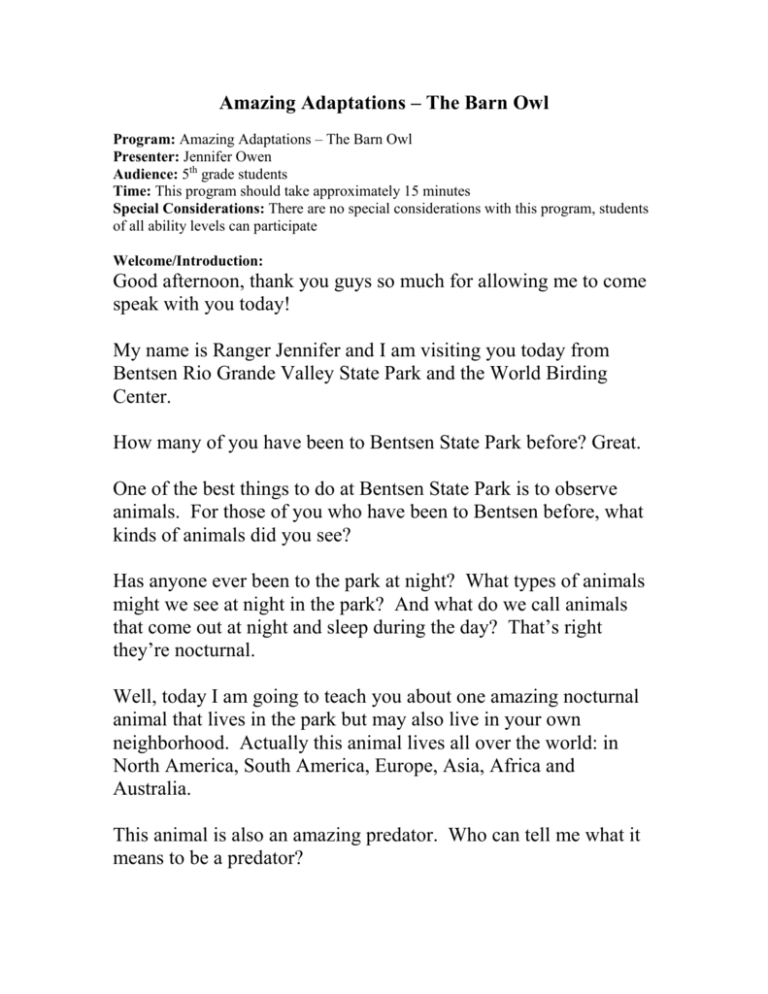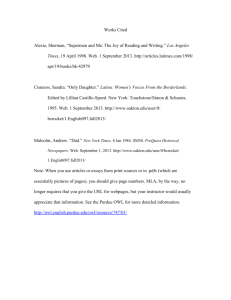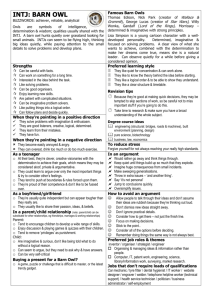Amazing Adaptations – The Barn Owl
advertisement

Amazing Adaptations – The Barn Owl Program: Amazing Adaptations – The Barn Owl Presenter: Jennifer Owen Audience: 5th grade students Time: This program should take approximately 15 minutes Special Considerations: There are no special considerations with this program, students of all ability levels can participate Welcome/Introduction: Good afternoon, thank you guys so much for allowing me to come speak with you today! My name is Ranger Jennifer and I am visiting you today from Bentsen Rio Grande Valley State Park and the World Birding Center. How many of you have been to Bentsen State Park before? Great. One of the best things to do at Bentsen State Park is to observe animals. For those of you who have been to Bentsen before, what kinds of animals did you see? Has anyone ever been to the park at night? What types of animals might we see at night in the park? And what do we call animals that come out at night and sleep during the day? That’s right they’re nocturnal. Well, today I am going to teach you about one amazing nocturnal animal that lives in the park but may also live in your own neighborhood. Actually this animal lives all over the world: in North America, South America, Europe, Asia, Africa and Australia. This animal is also an amazing predator. Who can tell me what it means to be a predator? That’s right, a predator is an animal that hunts and catches other animals for its food. So today we’re going to learn about a creature that comes out at night, is an excellent hunter and lives all over the world. I’m going to read you a little poem about this animal and see if you can guess which creature I am talking about. POEM Soaring through the darkness, Hunt with silent flight, Keen sight and hearing, Give those mice a fight. Feathers ‘round the face, Funnel light and sound, Helps this hunter notice, Movement on the ground. Sleep all day- hunt all night, Mammals, birds and more, Swallow them whole, one big gulp, Then pellets on the floor. Have you figured it out yet? What animal am I talking about? That’s right, an owl. More specifically a Barn Owl. Show specimen. This is a Barn Owl and today we are going to talk about what makes this animal such an excellent hunter. Point #1: Barn owl as a hunter Next question, can anybody tell me what this is? This is called an owl pellet. When an owl eats its prey it does not separate the meat from the bone like other predatory birds such as hawks. Owls don’t have any teeth and they certainly can not use a knife and fork like we do. Instead, owls will swallow their prey whole; hair, bones and all. This is like you swallowing a 15-pound hamburger in one gulp! To help process all of this food at once, the owl has two stomachs. The food goes into the first stomach and the digestive juices help separate the meat and food stuff from the indigestible items like bones, nails and hair. Then the food part is sent down to the second stomach and all of the other stuff is left in the top stomach. Then the first stomach squeezes all of this indigestible material together into what we call an owl pellet. Finally the owl regurgitates or spits up the owl pellet. This owl pellet was found at Bentsen State Park in an area known for Barn Owls. Can you guess what this owl might have eaten? Most likely a field mouse. But to be sure we could tear this owl pellet apart and try and figure out what the owl ate by looking at the bones in the pellet. It’s like putting a puzzle together. Now, how did this owl get this mouse to eat? Did it go to the grocery store or a drive thru? No of course not, the owl went out hunting. Owls are actually some of the most precise and successful hunters in the world. What do you think makes owls so good at catching their prey? And why is it important for the owls to be good hunters? Owls have evolved many sensory adaptations which allow them to be superior hunters. Today we will look at a couple of these adaptations. Point #2: Silent Flight I would like for you to imagine that we are all at Bentsen State Park. The sun has just set. A Barn Owl is emerging from its roost in the park pavilion. He is hungry. He needs to hunt, so he takes off to patrol the park for food. He flaps his wings, but makes no sound. He is completely silent. The feathers on the wings of an owl are specially adapted to slice through the air making for silent flight. Lets listen. I would like you all to close your eyes and listen quietly. First we will hear what the wing of another predatory bird, the Red-tailed hawk, sounds like. Flap cardboard hawk “wing”. Next let’s listen to what the sound of a barn owl’s wing sounds like. Flap cardboard owl “wing.” Could you hear a difference? Which one was louder? The owl’s wing has comb-like projections that slice through the air and reduce the noise. Why would silent flight be beneficial to an owl? Point #3: Hearing Ok, back to our hunting owl. He is flying silently above the park. Suddenly, he hears something moving in the leaf litter. Not right below him, but on the opposite side of the park. He flies quickly to investigate. Owls can actually hear a small mouse moving in the leaf litter from over 200 feet away! Owls have an extremely heightened sense of hearing. Lets take a look at our Barn Owl here. Where do you think his ears are? Barn owls have two ears just like us, one on each side of the head. That’s where the similarities stop. The barn owl has one ear positioned at the top of the head and one near the bottom of the head and one is larger than the other. This allows the owl to triangulate or pin point exactly where a sound is coming from. There is one other thing that helps the owl’s sense of hearing. Around their face, owls have modified feathers which form what we call a facial disc. How might this facial disc help the owl to hear better? The facial disc helps funnel the sound into the owl’s ears. Close your eyes again and listen to me snap my fingers. Now listen like an owl, cup your hands behind your ears, keep your eyes closed and listen to me snap. Could you tell a difference? Just like an owl’s facial disc, your hands funneled the sound into your ears and made it easier for you to hear me snap. Point #4: Eyesight Ok, lets think back one last time to our hunting owl in the park. He is now heading towards the sound he heard. Hoping it is food. As he travels, he is scanning the ground looking for any movement. Looking for his prey. An owl can see a mouse move one inch from over 100 feet away. Look at the eye sockets or orbits in this owl skull. What do you notice about them? They are pretty large, right? They take up almost ½ of the head. Why would an owl need large eyes? Most owls, like our Barn Owl are nocturnal and large eyes allow them to bring in more light so they can see better at night. Owls are the only birds with binocular vision. This means that their eyes are set on the front of their face looking forward, just like ours. This helps the owl see in 3 dimensions and gives them what we call depth perception. Lets do one last activity. I need two volunteers. One of you will be an owl and the other will be an insect such as a walking stick that the owl wants to catch and eat. Do activity with two eyes and with one. Was the walking stick easier to catch when you used only one eye or both? That’s because using both eyes allows you to have depth perception to pin-point exactly where your food is. Thank you. Lets give them a hand. Conclusion Can you guys help me name the adaptations that help the owl become a successful hunter? All of these things- silent flight, facial discs, asymmetrical or uneven ears and large forward facing eyes are adaptations that allow our hunting owl to swoop down, grab a mouse with its sharp talons and feast; bones, hair and all. And a day later we get this. The owl pellet. All of these adaptations make the owl an excellent hunter and overall help the animal to survive. If you guys want to know more about owls, come visit me at Bentsen State Park. We offer night hikes where we go looking for owls every Thursday night. Get your parents to bring you out to the park and come see some of these amazing animals for your self. Also you can visit you school or local library to check out books about owls and other predatory birds. I hope you have had fun this afternoon and I will take a few minutes if anyone has any questions.



